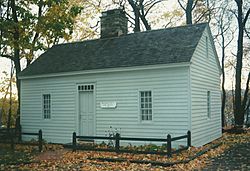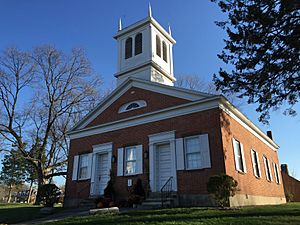Mill Hill Historic Park facts for kids

Fitch law office building ca. 1740
|
|
| Details | |
|---|---|
| Established | 1767 |
| Location | |
| Country | |
| Type | Historic site |
Mill Hill Historic Park in Norwalk, Connecticut, is a cool place to visit. It's like a living history museum where you can step back in time! The park has three old buildings and a historic cemetery.
The buildings include a "law office" from around 1740, a schoolhouse built in 1826, and the old Norwalk Town Hall from 1835. The cemetery is also known as the Town House Hill Cemetery. You might also hear it called the Mill Hill Historical Complex or the Norwalk Mill Hill Museum.
Today, the Norwalk Historical Society and the Norwalk-Village Green Chapter of the Daughters of the American Revolution take care of Mill Hill Park. You can find it on East Wall Street in Central Norwalk.
The cemetery, which is the third oldest in Norwalk, opened in 1767. It was started by the First Congregational church. Many people are buried there, including 11 brave soldiers who fought in the American Revolutionary War.
Contents
Explore Governor Fitch's Historic Law Office
The oldest building at Mill Hill is the "law office" of Governor Thomas Fitch IV. It was built around 1740. Governor Fitch was an important leader in Connecticut.
He passed away in 1774. During the British raid on Norwalk in 1779, his house was partly burned. This happened because his wife, Hannah, was a "Tory," meaning she supported the British. The British often spared homes of their supporters.
The Fitch family lived in the rebuilt house until 1945. In 1956, a part of the original house was saved. It was moved to Mill Hill when a new highway, the Connecticut Turnpike, was being built. In 1971, this part of the house was restored. It now looks like a law office from the 1700s, just like Governor Fitch would have used.
Step Inside the Old Schoolhouse
Norwalk had its first schoolhouse built around 1678. Over the years, several school buildings were used. One of them might have been burned during the British raid in 1779.
The schoolhouse you see at Mill Hill was built around 1826. It was first located near Willow Street and East Avenue. People called it the "Down Town District Schoolhouse." This was because that area was known as the "Down Town District" until the late 1800s.
The building served as a school until 1876. It was moved a few times over the years. When Interstate 95 was constructed, the schoolhouse was moved to its current spot at Mill Hill.
Discover the Norwalk Town House
When Norwalk was founded in 1651, people planned to build a "meeting house." This building was ready by 1659. It was used for both church services and town meetings.
By 1726, the church members wanted town meetings to be held somewhere else. So, town leaders started meeting in homes. Later, they used a school building. In 1736, the first "Town House" was built.
Another Town House was built on Mill Hill, but it was burned in the 1779 British raid. After the fire, a committee was formed to rebuild it. However, the new Town House wasn't finished until 1794. This building wasn't kept in good shape. By 1834, it was in such bad condition that people tore it down!
The Town House you see at Mill Hill today was built in 1835. Captain Lewis Raymond built it using bricks. This was one of the first brick buildings in Norwalk. This Town House was used for town business until 1913. After that, town meetings moved to South Norwalk’s City Hall.
Since 1924, the Norwalk Chapter of the Daughters of the American Revolution has used the Mill Hill Town House. They added a kitchen and bathroom. Today, the Town House displays historical items. It also hosts meetings, events, and educational programs for students.
Famous People Buried Here
Many important people from Norwalk's past are buried in the Mill Hill Burying Ground. Here are a few:
- Eliphalet Lockwood (1675–1753): He was a church leader (deacon) and served in the Connecticut House of Representatives.
- John Betts, Jr. (1692–1767): He was also a member of the Connecticut House of Representatives.
- Thaddeus Betts (1724–1807): A doctor and a member of the Connecticut House of Representatives.
- Taylor Sherman (1758–1815): He served in the Connecticut House of Representatives. He was the grandfather of the famous General Sherman.
- Edwin Lockwood (1799–1878): He was the Warden of the Borough of Norwalk.
More Local History to Explore


